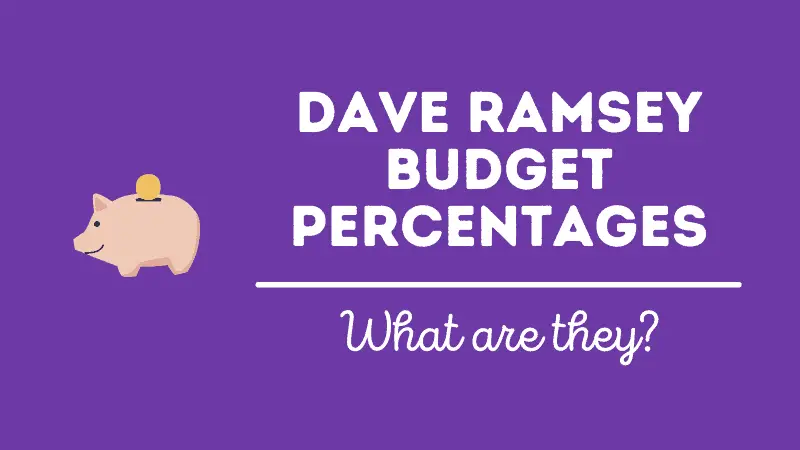If you’re just starting out on your financial journey, one of the first things people usually tell you to do is track your spending and create a budget.
That sounds good in theory, but where the heck do you even start? How much should you be spending in each category?!?
To get rid of some of the overwhelm, one thing you can do is follow a recommended budget or budget guidelines. One of the sample budgeting guidelines is the Dave Ramsey Budget Percentages.
Instead of using a set dollar amount for each category, there is a set percentage – so it can be used to fit any budget.
Here is the overview of the recommended household budget:
| Category | Percentage |
|---|---|
| Giving | 10% |
| Saving | 10% |
| Food | 10-15% |
| Utilities | 5-10% |
| Housing | 25% |
| Transportation | 10% |
| Health | 5-10% |
| Insurance | 10-25% |
| Recreation | 5-10% |
| Personal Spending | 5-10% |
| Miscellaneous | 5-10% |
Dave Ramsey’s Recommended Budget Categories
Now that you know what categories are included and what percentage of your income you should be spending in each category, let’s go over each one in more detail.
Giving: 10%
This giving category is for things like tithing and giving to charity. According to Dave Ramsey, this category is necessary to have, even if you’re in debt or have other investing/savings goals.
Saving: 10%
This savings category includes short-term and long-term savings, like emergency funds, sinking funds, and a house nonpayment. This category also includes any investing you’d like to do.
Food: 10-15%
The food category includes regular groceries, and can include eating out (or this can be part of recreation or personal spending).
If you’d like to lower your food spending, check out these 10 cheap meal plans.
Utilities: 5-10%
Utilities include your water, electricity, trash services, and gas/propane.
Housing: 25%
This housing category is rent, and if you own a home that means mortgage, your HOA, any PMI fees, and insurance and taxes.
For some people putting only 25% of their income into housing isn’t very realistic, but I think 25% is a good starting point, and it’s your budget after all, you can change it up to fit your own life.
Transportation: 10%
Your car payment and any other necessary maintenance for your car go into this category. That means gas, car tag renewals, oil changes, etc.
Health: 5-10%
The health category is for health related costs, like fees for annual checkups, copays for any medication, costs of any over-the-counter medication. Pretty much anything and everything health related (minus insurance!).
Insurance: 10-25%
The insurance category is for allll the insurances! I’m talking homeowners, renters, health, car insurance, life insurance.
All of it!
Recreation: 5-10%
Now this is the fun category, this can be eating out, going to the movies, concerts, whatever is entertaining for you!
Personal Spending: 5-10%
Personal spending money can be spend on anything you want. More eating out? New clothes? It’s up to you!
Miscellaneous: 5-10%
Every budget should include some wiggle room for expected expenses or little things that just happen to pop up.
Some Potential Issues With The Dave Ramsey Budget Percentages
If you’re wanting to use this type of budget yourself, there are some things you might want to adjust/add.
- Debt Repayments – So this budget is for people that don’t have any debt (except possibly mortgage), that’s really the only way the budget can work as-is, since there’s no room for debt payments. If you do have debt, you could use the “Savings” category for debt payments, or you can create a separate category and just spend less in the other categories to make room.
- Low Savings Rate – 10% is a great savings rate if you’re just starting out, but if you’re a bit older, or you have bigger goals, saving just 10% for your short-term goals, and long-term goals like retirement just won’t cut it in the long run. This is definitely a category you should be adjusting at some point in your financial journey.
Sample Budget Using Dave Ramsey’s Budget Percentages

Now let’s use the Dave Ramsey Budget Percentages to create a sample budget so you can see this budget in action, and so you can see if the Dave Ramsey Budget Percentages are actually realistic.
Sample Budget Using US Median Income ($31,133)
For this example, we’re going to use the median income in the US from 2019, which was $31,133 (US Census Bureau), and monthly this would be about $2595.
| Category | Dave Ramsey Budget Percentage | Amount (Monthly) |
|---|---|---|
| Giving | 10% | $259.50 |
| Saving | 10% | $259.50 |
| Food | 10% | $259.50 |
| Utilities | 5% | $129.75 |
| Housing | 25% | $648.75 |
| Transportation | 10% | $259.50 |
| Health | 5% | $129.75 |
| Insurance | 10% | $259.50 |
| Recreation | 5% | $129.75 |
| Personal Spending | 5% | $129.75 |
| Miscellaneous | 5% | $129.75 |
Most of the categories look okay for this budget, but with housing at just $648.75 per month… It might not be possible to get that if you live in a high cost of living area like the pacific northwest, California, etc.
If you do live in a high cost of living area, you may have to adjust other categories to make room for your housing budget, which would throw a lot of this budget off.
Sample Budget Using Income ($60,000)
For this example, we’re going to use an income I pulled from the “middle class” category from this article. The range given was $53,413 – $106,827, so I decided to go with $60,000, and monthly this would be about $5000.
| Category | Dave Ramsey Budget Percentage | Amount (Monthly) |
|---|---|---|
| Giving | 10% | $500 |
| Saving | 10% | $500 |
| Food | 10% | $500 |
| Utilities | 5% | $250 |
| Housing | 25% | $1,250 |
| Transportation | 10% | $500 |
| Health | 5% | $250 |
| Insurance | 10% | $500 |
| Recreation | 5% | $250 |
| Personal Spending | 5% | $250 |
| Miscellaneous | 5% | $250 |
I think the percentages work a lot better for this income level than the $31k budget.
The only issue that I see here is the savings, if you’re trying to save for retirement and other goals at the same time, I don’t think $500 is enough for everything.
But the other categories look pretty good!
Sample Budget Using High Income ($150,000)
For this example, we’re going to use an income I pulled from the “upper-middle class” category from this article. The range given was $106,827 – $373,894, so I decided to go with $150,000, and monthly this would be about $12,000.
| Category | Dave Ramsey Budget Percentage | Amount (Monthly) |
|---|---|---|
| Giving | 10% | $1,200 |
| Saving | 10% | $1,200 |
| Food | 10% | $1,200 |
| Utilities | 5% | $600 |
| Housing | 25% | $3,000 |
| Transportation | 10% | $1,200 |
| Health | 5% | $600 |
| Insurance | 10% | $1,200 |
| Recreation | 5% | $600 |
| Personal Spending | 5% | $600 |
| Miscellaneous | 5% | $600 |
For this higher income level, I think the percentages work pretty well! What do you think?
Dave Ramsey Budget Percentages Compared to Other Budgeting Methods
There are quite a few other budgeting methods and budgeting guidelines out there. Let’s compare those other budgeting methods to the Dave Ramsey budget.
50/30/20
Have you heard of this one before?
This budget is where you put 50% of your income towards your needs like housing, food, utilities, insurance, and transportation, 30% of your budget towards wants, and you put 20% of your budget towards saving and debt payment.
I think this is also a great budget to start with since there is room for debt payment!
70/20/10
The 70/20/10 budget method is something I found from Fun Cheap or Free. It’s similar to the 50/30/20 budget.
70% of your income will go towards expenses (this includes wants and needs), 20% of your income will go towards savings and debt, and 10% goes towards giving to charity, college savings, and investing.
Dave Ramsey Budget Percentages vs. Kelly Anne Smith’s Budget
Final Thoughts About Dave Ramsey Budget Percentages
The budget percentages are a great starting point to use when you’re first creating your budget, but as some of the sample budgets show, it can be hard to use at every income level, and it’s not really a one-size fits all solution.
Basically, if you aren’t able to get your budget to fit neatly into the Dame Ramsey Budget Percentages, I wouldn’t worry, I think it would be hard for most people to get it exactly right.
Sources
- How to Determine Budget Percentages (Ramsey Solutions)

